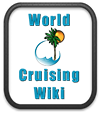Canaries to Senegal – and a Personal Best
Current Position: 14 43.1 N 017 25.66 W Click to view map.
Distance sailed since last post: 4 nautical miles. View the map of our voyage track here
This crossing of 842 miles was like our Lisbon to Morocco crossing – but more so.
We set off with very light winds which, unfortunately disappeared totally for a while overnight. We resisted the urge to motor, but when our speed went to zero and we lost all steerage it is hard to know what to do. Does one just drop the sails and drift until the wind fills in again? Or does one motor, even if slowly, to at lease keep steerage? In the end we opted for the latter.
Even so, we knew the wind was coming. And, sure enough, by midnight the wind had arrived, and we were sailing. Only doing 1.8kts, but at least we were moving and we could steer. Over the next four hours we gybed several times as the fickle wind decided what it was going to do. By 5 am it had finally decided it would obey the forecast. We did a final gybe, our speed went up to over 3 kts, and we were on our way!
Before long we had the spinnaker up, and were creaming along on smooth water at 5.5 kts. The sun was out, and it was simply beautiful.
Gradually the wind picked up, as we knew it would. The spinnaker came down at supper time, and we settled in to our broad reach that would take us all 800 miles to Senegal. This is what trade wind sailing is supposed to be about!
From that point on, there is not so much to say. The wind gradually increased until it was a steady 24kts apparent. By then we were down to our second reef, and still we were flying. The waves were a good 2m high, so that gave us some epic surfing, with speeds up to 14kts briefly. But the real proof of the conditions was our daily average. From 01:00 hrs on Tuesday we were up to speed: a steady 8+kts. We held this speed for almost two full days, giving us a 48 hour run of 384 nm (8 kt average) and a 24 hour best of 201 nautical miles (8.375 kt average). Yes, we broke the 200 nm in a day barrier! Wow! Now is flying!
The wind then decided to drop a little, but the forecast was still for an increase again, so we decided to leave the reefs in for the next night, which then cut our day’s run to about 190 miles – which would previously have been a personal best.
In the middle of one night we were about to meet nose to nose with a Spanish fishing veseel with a closest point of approach, according to the AIS of a few meters. He would not respond to the radio. So, what to do? Normally one would turn to starboard (right) so as to pass each other port to port. But that would mean going onto a run, which I was a bit nervous about in these waves that were tossing us around. The alternative was to harden up and cross his bow to cross starboard to starboard, which we could do with better control. But since I couldn’t confirm that with him, what happens if we wakes up and then decides to turn to his starboard. as he would be expected to do?
In the end I decided to bear away, and we managed to squeak by with only half a mile of sea room between us. It is tricky at night, as it is impossible, visually, to determine how far away a ship is. Fortunately the AIS and radar provide nice reasurance that one is going to miss them.
Finally, as we were just passing him, he woke up and spoke, in Spanish, on the radio. He still had made no effort to change course. I decided to ignore him, as my Spanish is insufficient to swear at him.
So that was our one incident of excitement. Apart from that, it was just FAST SAILING and it looked like we would be on track to arrive in daylight on Friday.
Alas, all good things come to an end. The wind then eased a bit. The sea was smoother, but our speed dropped just enough to mess up our daylight arrival.
But first we had just a little bit more excitement. About three hours before landfall I thought I saw a fish on one of our lures. But when we brought it in, there was nothing. What we did notice, however, was that the hooks were all blunt again! How could that be? It seems these hooks get a bit a rusty and go blunt all by themselves.
So I sharpened them, and put them out again. Sure enough, within an hour we had caught a nice little tuna. Perfect for supper.
And then, just as the sun was setting, we spotted land.
The sun might have gone, but the three-quarter moon was bright in the almost clear sky. We still had 20 or so miles to sail around the point to get to the anchorage, but with such a bright moon, that was no bother at all. We ate our tuna and glided past the Madaleine island rocks, the bright lights of the city, then Goree Island, of slave trading infamy, and round the corner to anchor in 3m a good way off the shore at Hann, where there are two yacht clubs. Thank goodness for GPS and radar! In the morning we would move closer, when we could see better where to go.
So that was it. 842 miles in 5 1/2 days for an overall average of 6.37 kts, including an record breaking 200 nm day in the middle. Not bad, considering our first day was only 80 miles.
And so, after 51/2 years away, Life Part 2 is back in the tropics.






Having coffee with the ladies, everyone says hi, have a wonderful time. Aunt Lou